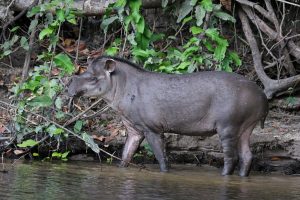SOUTH AMERICAN TAPIR
 Scientific name: Tapirus terrestris
Scientific name: Tapirus terrestris- IUCN Status : Vulnerable
- The South American tapir or the Brazilian tapir is the second largest mammal in South America.
- Tapir are often thought to be meek and gentle animals, however their behaviour can be unpredictable and they have been known to attack without warning.
- Amazonian tapirs (also known as lowland or Brazilian tapirs) are one of the largest mammals found in South America. Weighing in at anywhere between 350 to 600 pounds, adult tapirs have rather corpulent bodies. Unusual in appearance, tapirs have thick necks, stumpy tails, and large ears.
- They are becoming rare in their habitats, mostly due to habitat destruction and poaching, and they are designated as either Vulnerable or Endangered as a result..
- The South American tapir can be found near water in the Amazon Rain forest and River Basin in South America, east of the Andes.
- T. terrestris is an excellent swimmer and diver, but also moves quickly on land, even over rugged, mountainous terrain.
- The South American tapir is an herbivore.
- Using its mobile nose, it feeds on leaves, buds, shoots, and small branches it tears from trees, fruit, grasses, and aquatic plants.
